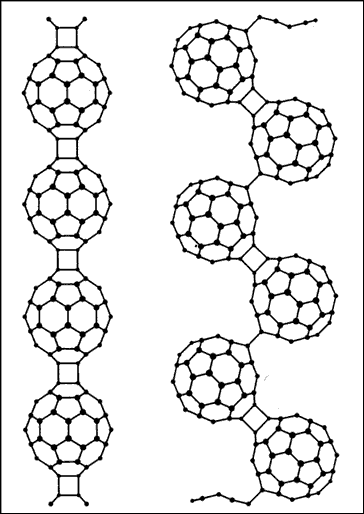
This Article From Issue
March-April 2001
Volume 89, Number 2
DOI: 10.1511/2001.18.0
Fullerene Polymers and Fullerene Polymer Composites. Peter C. Eklund and Apparao M. Rao (eds.). xv + 394 pp. Springer, 2000. $99.
Like many true molecules, the icosahedral 60-carbon clusters—buckyballs—are able to aggregate in molecular crystals with weak intermolecular van der Waals bonding. In this state the slippery buckyballs are free to change their mutual orientation or even to rotate around the molecular centers while preserving a perfect crystalline lattice order. However, a gentle push—hydrostatic pressure, excitation by light or other factors—can promote a stronger covalent bonding between the C60 molecules, thus allowing them to share some of their electrons. This process leads to formation of polymerlike chains (pearl necklaces) or rigid three-dimensional networks. It also dramatically changes the electronic and optical properties of the bulk material. In spite of the incurred covalent bonds, the buckyballs preserve their morphological individuality while revealing numerous fascinating properties of a collective nature.

From Fullerene Polymers and Fullerene Polymer Composites
Fullerene Polymers and Fullerene Polymer Composites offers a well-balanced collection of reviews, ranging from introductory, nonexpert material to more focused and technical descriptions of specific aspects of both theoretical and experimental studies. Although those working in the field will probably benefit most from reading the book, a broader audience will likely find it enlightening and perhaps inspiring: Topics covered include crystallography, photochemistry and photophysics, conductivity and superconductivity, theories of exciton and polaron transport, and issues regarding physicochemical synthetic methods. In fact, the first two chapters are clearly intended for a broader readership and constitute an excellent introduction to the field, whereas the other nine address specific research areas. Three of those are written by prominent theorists, presenting the results of electronic-structure and molecular-dynamics computations of a variety of structures, from the archetypal figure 8– shaped single- or multibonded C60-dimer to the more extensive two- and three-dimensional polymer networks.
That is what this book is mostly about: It brings the reader up to date on the field of fullerene polymers. The contributors are active, internationally recognized researchers. Also discussed are networks in which the buckyballs are attached to more common polymer chains, connecting remotely spaced fullerene pendants. This branch of fullerene studies, which was briefly outlined in a single chapter of the remarkable book Science of Fullerenes and Carbon Nanotubes (which Eklund coauthored with Mildred S. Dresselhaus and Gene Dresselhaus [Academic Press, 1996]), is highlighted here.
Fullerene Polymers and Fullerene Polymer Composites offers a well-balanced collection of reviews, ranging from introductory, nonexpert material to more focused and technical descriptions of specific aspects of both theoretical and experimental studies. Although those working in the field will probably benefit most from reading the book, a broader audience will likely find it enlightening and perhaps inspiring: Topics covered include crystallography, photochemistry and photophysics, conductivity and superconductivity, theories of exciton and polaron transport, and issues regarding physicochemical synthetic methods. In fact, the first two chapters are clearly intnded for a broader readership and constitute an excellent introduction to the field, whereas the other nine address specific research areas. Three of those are written by prominent theorists, presenting the results of electronic-structure and molecular-dynamics computations of a variety of structures, from the archetypal figure 8-shaped single- or multibonded C60-dimer to the more extensive two- and three-dimensional polymer networks.
The small number of misprints scattered throughout the book represents far less statistical noise than would be expected for a 400-page multiauthor volume. The book contains many very informative technical illustrations, a useful comprehensive index and a complete up-to-date bibliography. (In a rare exception, one author refers to one of his own papers as "submitted, 1995," but the reader can rest assured that these excellent reports have long since been published.)—Boris I. Yakobson, Mechanical Engineering and Materials Science, Center for Nanoscale Science and Technology, Rice University
American Scientist Comments and Discussion
To discuss our articles or comment on them, please share them and tag American Scientist on social media platforms. Here are links to our profiles on Twitter, Facebook, and LinkedIn.
If we re-share your post, we will moderate comments/discussion following our comments policy.